Aloha! Did you miss me? I’m Shelly Valladolid, otherwise known as The Fabulous Disney Babe. I wrote about Disney, went home to Hawaii to get my mind, body and soul back to health, went to college to try to learn how to write good, got married, got happy, and here I am, with a story about an attraction in a place near and dear to my heart, my favorite defunct theme park, EPCOT Center (which turns 32 years old today, October 1st).
For many years, when EPCOT Center was still more like a permanent World’s Fair than the mishmash of barely-themed thrill rides and “Innoventions” that is now called Epcot, the most-photographed spot on Disney property was not, as most people supposed, the towering Cinderella Castle in the Magic Kingdom. Instead, it was the display of cars at the exit of GM’s World of Motion attraction, which featured not only out-of-this-world concept cars, but also models of cars that families could go home and buy from their neighborhood GM dealerships in the near future. While we never saw the “Lean Machine” become common on our city streets, the ultra-futuristic (in those days) Corvette dream machine not only influenced the Batmobile in the Tim Burton movies, but is seen in the curves and lines of the models on the streets for the past several years.
Here’s a fun track to listen to as you read this article:
The attraction itself was a marvel as well: a huge cast of audio-animatronic characters, funny gags, and a nod back to one of the early wonders of Imagineering, Magic Skyway at the Ford Wonder Rotunda from the 1964-65 World’s Fair in Flushing Meadows, NY. To be honest, for many of us, EPCOT Center’s Future World was the closest we’d ever get to an actual World’s Fair.
The World’s Fair was the proving ground for much of Walt’s theme park vision: it’s a small world, Great Moments with Mr. Lincoln and the Carousel of Progress are fondly-remembered carryovers from the fair, but there was a fourth Disney attraction that people don’t seem to mention quite as often, one which carried over into not one, but at least FIVE attractions: the Disneyand Railroad, Universe of Energy, Disneyland’s WEDWay PeopleMover, Spaceship Earth and, of course, World of Motion.
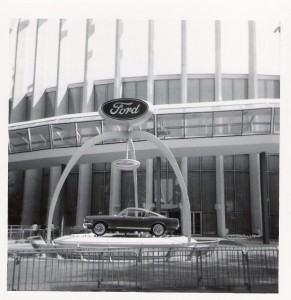
Walt himself narrated part of the attraction, along with Henry Ford II, and the narration came through sharp and clear from the car’s radio. If you changed the station, you could hear one of three other languages used for narration. For transcripts of the attraction (as well as some hilarious memories from people who were mischievous kids at the time) go to this page at NYWF64.com
David Oneal has posted an amazing video to YouTube of Magic Skyway testing:
The vehicles themselves were not rolling under their own power, but instead were moved along the ride by a series of wheels actually imbedded in the track. This was how the PeopleMover worked in Anaheim as well, changing to linear induction for Walt Disney World’s Tomorrowland.
The attraction itself was a fantastic trip through time, starting with dinosaurs, then cavemen, leading to the “freedom” imparted by the invention of the wheel. As the saying goes, “It’s fun to be free.” Upon entering their Ford Convertible, (the Galaxie seems to have been fairgoers’ favorite, if the stories they tell now are to be believed) the passengers travel back in time through a tunnel of flashing colored lights, to the realm of the dinosaurs! These are the same dinosaurs that we see in the Primeval World section of the Disneyland Railroad, munching on grasses in a lake, hatching from eggs, and fighting. In fact, these are the EXACT same dinosaurs (with some upkeep in the last fifty years, let’s be honest) that were on the Magic Skyway.
Next, we see cavemen learning to communicate through speech “There’s a giant bear behind you!” seems to be the first attempt, to a cooperative mammoth hunt, to man’s first attempts at art, to the inventor of the wheel selling his product to the tribe as his first attempt, a square wheel, lays rejected on the cave floor. Next, a tunnel filled with animated wheels of all types, spinning wildly, leads to the city of the future as envisioned by Walt and his Imagineers: a futuristic city with transportation tubes, sleek towers rising to the sky and no pollution. Walt comes on the radio to tell passengers that this could very well be their future.
With this hopeful picture still in their mind’s eye, passengers debark to visit some of the exhibits WED has created for the rotunda: miniature “International Gardens” with some animated pieces in them, such as a camel that moved through a Middle-Eastern village; a “Magic Mirror” showing what seemed to be endless rows of Model T’s in an effect that could make a bar seem a mile long; the Auto Parts Harmonic Orchestra and other wonders.
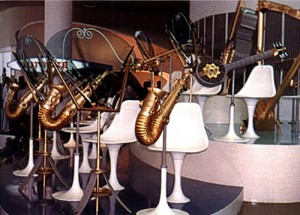
When the fair ended, Ford took the orchestra, Disney took the PeopleMover and dinosaurs and the rest was lost in the sands of time…as much as any good idea is ever lost at Disney. When GM and WED partnered on World of Motion, many things from Ford’s Wonder Rotunda found a rebirth: the story of man’s search for means of transportation, from foot power to the invention of the wheel (the “square wheel” gag was also resurrected, but more historically accurate), the mantra of transportation equaling freedom (the theme song for the ride was “It’s Fun to be Free”, even the time tunnels with the animated wheels made a return. In addition to the original Marc Davis gags, Ward Kimball came in and wrote a cohesive story about the journey from feet to rockets and beyond, culminating in a vision of the city of the future, with no tubes this time, but the same idealistic city with immense skyscrapers and a Pepper’s Ghost effect that turned the omnimover ride vehicles into sleek, futuristic fantasy. Like the Wonder Rotunda, World of Motion was housed in a round building (like a wheel) with a large chunk of the front made of glass – behind which was the GM corporate lounge. The view from these windows is nothing short of spectacular, and they are part of the few things from the original that remain.
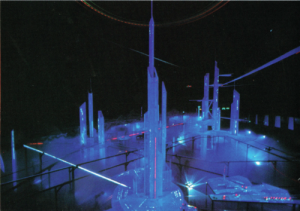
At the exit of the attraction were several exhibits – no International Gardens, but concept cars, “Bird and the Robot”, featuring a bird from Tokyo’s Enchanted Tiki Room, and a showroom floor of current and near-future GM automobiles – the most photographed place at Walt Disney World, at the time.
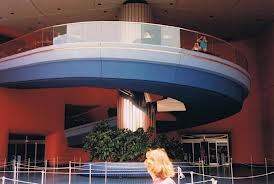
When WED field-tested the PeopleMover system in Glendale, they made a video of it, showing passengers getting in and out of the car (aided by Imagineer John Hench) and great details of how the system actually worked.
The title WED gave the promotional film?
“TEST TRACK”.
EDITORS NOTE: Please join us in welcoming Shelly back to the wonderful world of Disney blogging!


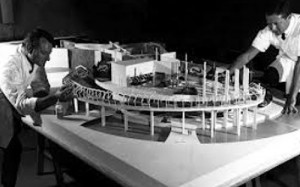
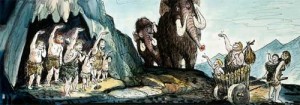
You must be logged in to post a comment.